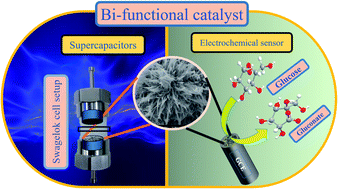PANI/g-C3N4 composite over ZnCo2O4/Ni-foam, a bi-functional electrode as a supercapacitor and electrochemical glucose sensor†
Abstract
Zinc cobaltite (ZnCo2O4) was successfully hybridized with conductive polyaniline (PANI) and graphitic carbon nitride (g-C3N4) as an applicable hybrid ternary composite toward supercapacitors and electrochemical glucose sensing. The electrodes were prepared in two steps, hydrothermal approach to develop ZnCo2O4/Nickel foam, followed by in situ chemical oxidative polymerization for g-C3N4/PANI over ZnCo2O4/Nickel foam. For the confirmation of synthesized materials, some of the primary characterization tools such as X-ray powder diffraction, Fourier transform infrared spectroscopy and Raman spectroscopy were used. Surface area analysis was performed by obtaining nitrogen adsorption and desorption isotherms. Considering, practical applications toward electrochemical devices, kinetics studies were carried out using the rotational disk electrodes to obtain kinetic parameters. Further, morphological images and electronic structure were obtained via field emission scanning electron microscopy and X-ray photoelectron spectroscopy, respectively. This hybrid ternary composite electrochemical properties was analyzed using a three electrodes electrochemical cell; composites provided a synergistic effect with higher surface-active species, which exhibited a specific capacity as high as 738 F g−1 at 2 A g−1 in 6 M KOH electrolyte. For practical applications, asymmetric supercapacitors were fabricated with carbon-based electrodes, and solid-state supercapacitors were placed inside of the Swagelok cell setup for performance investigation. Supercapacitors demonstrate admirable specific capacitance of 24.8 F g−1 at 0.2 A g−1 and cycle stability with a 100% retention of specific capacitance even after 2000 cycles. Further, the asymmetric supercapacitor exhibited potential output with a power density of 375 W kg−1 and an energy density of 6.35 W h kg−1 at 0.4 A g−1. Moreover, the prepared materials were used in the application of electrochemical sensors for effective oxidation of glucose, in which kinetics were due to the diffusion-controlled electrochemical process for glucose oxidation. The ternary composite ZnCo2O4/g-C3N4/PANI-fabricated electrode delivered excellent sensor parameters with a sensitivity of 15.64 mA mM−1 cm−2 in the linear range of 0.1 mM to 3 mM with an acceptable detection limit (LOD) of 4 μM. Further, in-depth studies such as selectivity and durability were carried out to verify the effectiveness of the electrochemical glucose sensor. This work shows that the ternary composite ZnCo2O4/g-C3N4/PANI could be a potential and promising electrode material for the supercapacitor and electrochemical glucose sensing applications.



 Please wait while we load your content...
Please wait while we load your content...